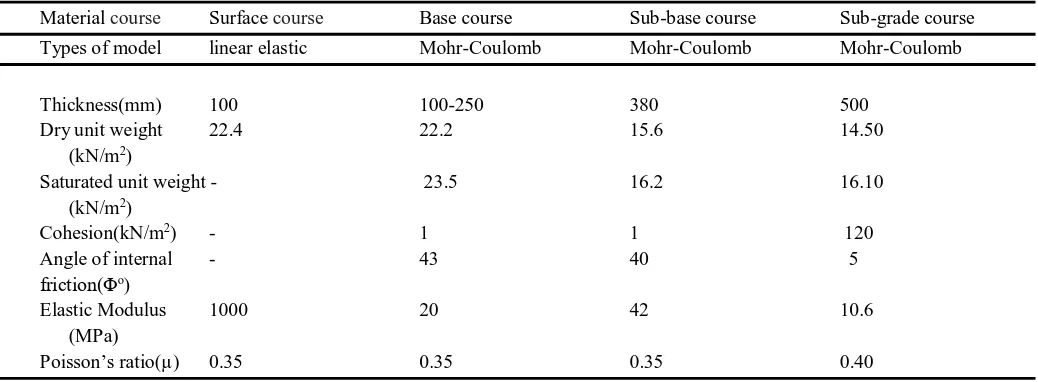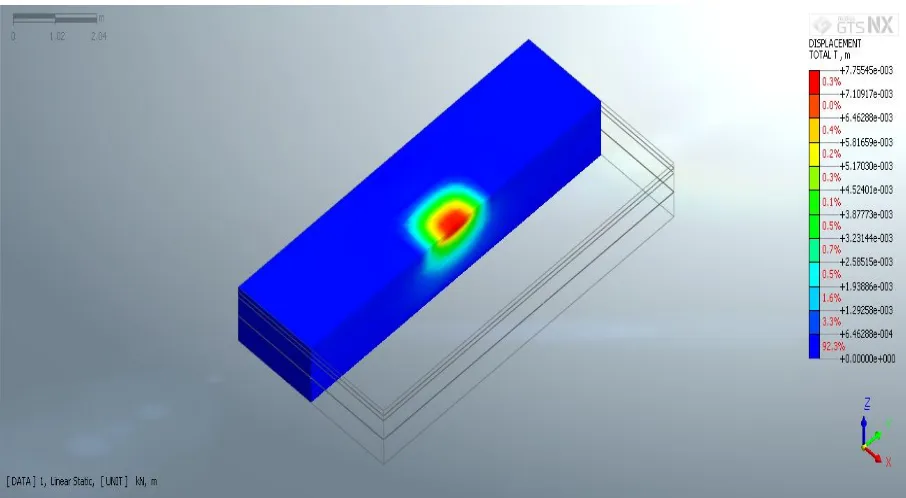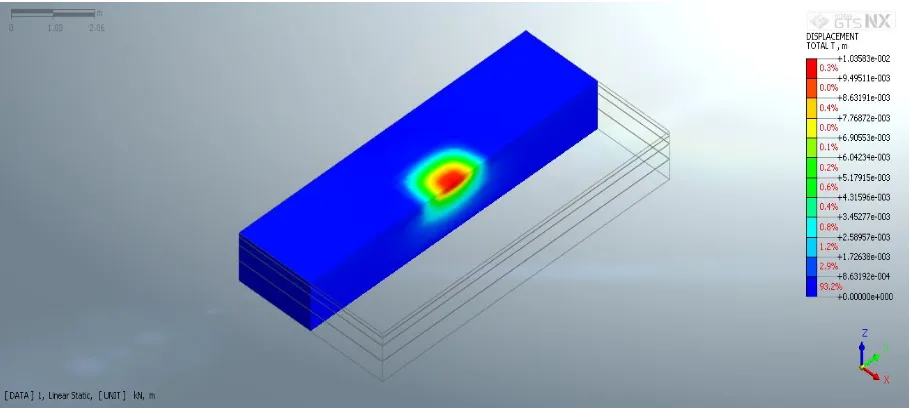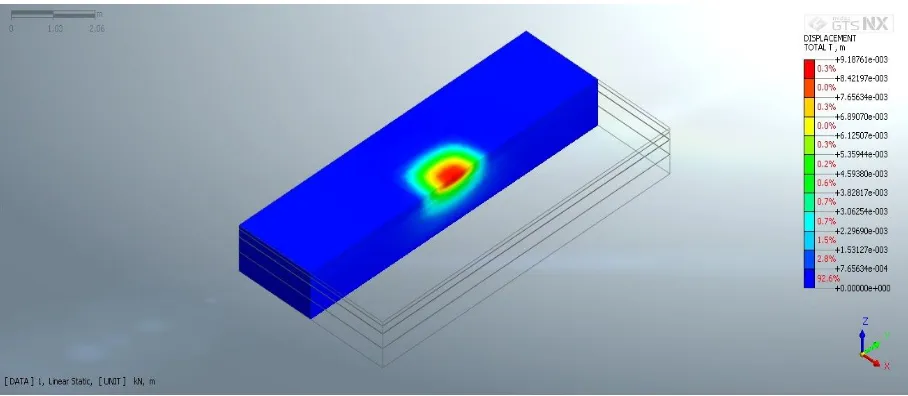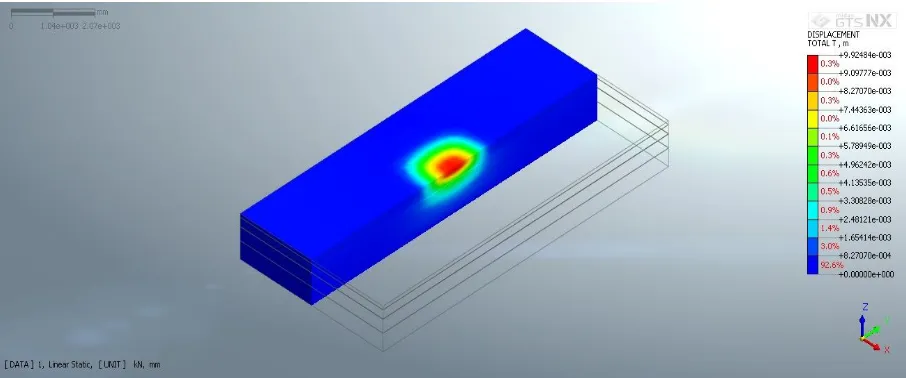748
©IJRASET: All Rights are Reserved
Study of Flexible Pavement Layer Reinforced
Geogrid with FEA
Shivam Upadhyay
1, Prof. Pratibha Singh
2, Dr. Manoj Trivedi
31PG student, 2Asst. Professor, 3Professor, civil engineering department, Madhav Institute of Technology and Science, Gwalior,
(M.P.) India
Abstract: In civil engineering, geosynthetic is broadly used as reinforced material in various field. The practice of using geosynthetics is extensively used in the road surface construction. Many have been accompanied to study the behaviour of soil reinforced with different types of geosynthetics and while constructing roads on a weak subgrade geogrid can be used as a reinforcement which will improve the performance of these roads by reducing permanent deformation. The finite element analysis is a finest appropriate tool for solving problems related to nonlinear nature of materials. This study illustrates the working of geosynthetics in flexible pavement through finite element analysis with MIDAS GTS NX software. In sub-grade layer, sub-base layer, base layer Mohr-Coulomb theory used and elastic behaviour in surface course and geosynthetics to act out the intraction condition. The hexahedral element of 8-node is used for strata of pavements. The vehicle loading and thickness of of each layer was used according to codal provisions of Indian Road Congress (IRC : 37-2012). In this study, model which is
symmetrical about an axis using MIDAS GTS NX for investing the effect the axial stiffness of geosynthetics in the pavement. The FEA results shows the decline in vertical deformation when geosynthetics were added between the layers.
Keywords: Finite element analysis, geosynthetics, flexible pavement, deformation, axial stiffness.
I. INTRODUCTION
749
©IJRASET: All Rights are Reserved
geogrid is carried out by using midas gts nx software and analysis the effect of th vertical displacement in pavement due to load while reinforcing geogrid between different layers of flexibile pavement.
II. MATERIALSANDMETHODS
A. Finite Element Analysis
A 3-dimensional linear finite element tool was used to modelling a flexible pavement section. MIDAS GTS NX is a simulation program developed for the evaluation of soil-structure interaction based on the finite element method. GTS NX helps engineers to perform step-by-step analysis of excavation, banking, structure placement, loading and other factors that directly affect design and construction.
The program supports various conditions (soil characteristics, water level etc.) and analytical methodologies to simulate real phenomena.
A model of pavement section contains surface course, base course, sub-base course, and subgrade course. The flexibile pavement model as a multilayer structure to static loading according to codal provisions of IRC: 37-2012. The pavement prototype is using GTS NX software for analyzing the base layer thickness with and without geosynthetics. The thickness of pavement layer was elected as per IRC: 37-2012 and design traffic intensity considered 150 MSA. The total thickness of pavement was vatied from 1080
to 1230 mm. A uniform loading of 575 KN/m2 was applied which is equivalent to a single wheel load of 4080 kg.
An easy way to comply with IJRASET paper formatting requirements is to use this document as a template and simply type your text into it.
III. METHODOLOGY
A three-dimensional modeling used for flexible pavement. Hexahydral element (8 nodes) are used for this analysis. In this study, 8 noded hexahydral structural solid element use for modeling of the pavemnt section. Boundary conditions of the model were taken as sides are constraint so that stress distribution would be minimum. Four layered pavement prototype with rectangular area 10mx5m considered & tyre pressure applied at the middle of the pavement on a small assumed square area, which is equivalent to 8 times the tyre radius (15cm) of the surface contact area. Vertical displacement allowed. Unreinforced and 3 different types of reinforced models used for the d\study the effect of reinforcement on the pavement section. Reinforced models are:-
A. Geosynthetics between subgrade and sub-base course.
B. Geosynthetics between sub-base and base course.
[image:2.595.40.559.510.701.2]C. Geosynthetics between subgrade, sub-base and base course.
Table 1 : Flexibile Pavement Properties
Material course Surface course Base course Sub-base course Sub-grade course
Types of model linear elastic Mohr-Coulomb Mohr-Coulomb Mohr-Coulomb
Thickness(mm) 100 100-250 380 500
Dry unit weight 22.4 22.2 15.6 14.50
(kN/m2)
Saturated unit weight - 23.5 16.2 16.10
(kN/m2)
Cohesion(kN/m2) - 1 1 120
Angle of internal - 43 40 5
friction(Φo)
Elastic Modulus 1000 20 42 10.6
(MPa)
750
[image:3.595.73.523.243.459.2]©IJRASET: All Rights are Reserved
Table 2 : Geosynthetics Properties
Types Of Materials Axial Stiffness Elastic Modulus
Geogrid 1000kN/m 535100 kN/m2
IV. RESULTS
In this study, finite element analysis is determine the effects of geosynthetics in pavement base layers of different thickness and different layers. The outcomes of the analysis shows the benefical effects of the axial stiffness of geogrids in the base course at different thickness of base course layer on vertical deformation as shown in figures.
Fig 1(a):Total displacements for unreinforced pavement of base layer 100mm.
[image:3.595.70.523.484.733.2]751
©IJRASET: All Rights are Reserved
Fig 1(c):Total displacements for reinforced pavement of base layer 100mm (geogrid between sub-base & base )
Fig 1(d):Total displacements for reinforced pavement of base layer 100mm (geogrid between subgrade, sub-base & base )
[image:4.595.67.523.109.276.2] [image:4.595.75.529.302.500.2] [image:4.595.71.526.526.730.2]752
©IJRASET: All Rights are Reserved
Fig 2(b):Total displacements for reinforced pavement of base layer 200mm (geogrid between subgrade & sub-base )
Fig 2(c):Total displacements for reinforced pavement of base layer 200mm (geogrid between sub-base & base )
[image:5.595.71.525.302.500.2] [image:5.595.71.526.528.725.2]753
©IJRASET: All Rights are Reserved
Fig 3(a):Total displacements for unreinforced pavement of base layer 250mm.
Fig 3(b):Total displacements for reinforced pavement of base layer 250mm (geogrid between subgrade & sub-base )
[image:6.595.69.524.106.277.2] [image:6.595.71.524.302.499.2] [image:6.595.71.524.525.714.2]754
©IJRASET: All Rights are Reserved
Fig 3(d):Total displacements for reinforced pavement of base layer 250mm (geogrid between subgrade, sub-base & base )
V. CONCLUSIONS
The finite element analysis results indiaceted that geogrid-reinforced pavement has less deformation as compared to unreinforced flexibile pavement for same thickness of base layer and loading conditions. Total deformation of surface shown in fig 1 to 4 with respect to variation in pavement. The finite elemnt results are discuss in terms of surface deformation. The conclusions of this study are as follows:-
A. Vertical surface deformation in flexible pavement reinforced with geogrid are reduced as compared to unreinforced pavement.
B. Reduction in total surface displacement is 5% (without reinforcement of geogrid and 100mm thick base layer) to 14% (with two
geogrid reinforcemnet between subgrade, sub-base & base layer; and 250mm thick base layer).
C. Reduction increase when thickness of base layer increase.
D. Reduction in stress genertaed in the different layers of flexibile pavement.
REFERENCES
[1] Barksdale, R.D., Brown, S.F. and Chan, F. 1989. Potential benefits of geosynthetics in flexible pavement system. National Cooperative Highway Research Program, Report No. 315, Transportation Research Board, Nation Research Council, Washington, DC.
[2] Jorge G, Zornberg, “Functions and Applications of Geosynthetics in Roadways”, Transportation Geotechniques and Geoecology, May 2017, pp. 298-306.
[3] S.K.Ahirwar, J.N.Mandal (2017) “ Finite Element Analysis of Flexible Pavement with Geogrid”, Transportation Geotechnics Geoecology.
[4] Erickson, H., Drescher, A. (2001). The use of geosynthetics to reinforce low volume roads. Minnesota Department of Transportation.
[5] Gonçalves, M.M. (2015). Influence of the use of geosynthetics in the design of road pavements. Master Thesis, Instituto Superior Técnico, University of Lisbon, Portugal. (in Portuguese).
[6] Kim, M., Lee, J.H. (2013). Effects of geogrid reinforcement in low volume flexible pavement. Journal of Civil Engineering and Management, S14-S22.
[7] Lima, H. (2013). Geomaterials used in pavement subgrade since 2001 to 2012. EP (in Portuguese) Mounes, S.M., Karim, M.R., Mahrez, A., Khodaii, A. (2011). An overview on the use of geosynthetics in pavement structures. Scientific Research and Essays, 6, 2234-2241.
[8] Neves J, lima H, Gonçalves (2016) “ A Numerical study on the inplication of subgrade reinforcement with geosynthetics in pavement design”.
[image:7.595.47.532.90.275.2]